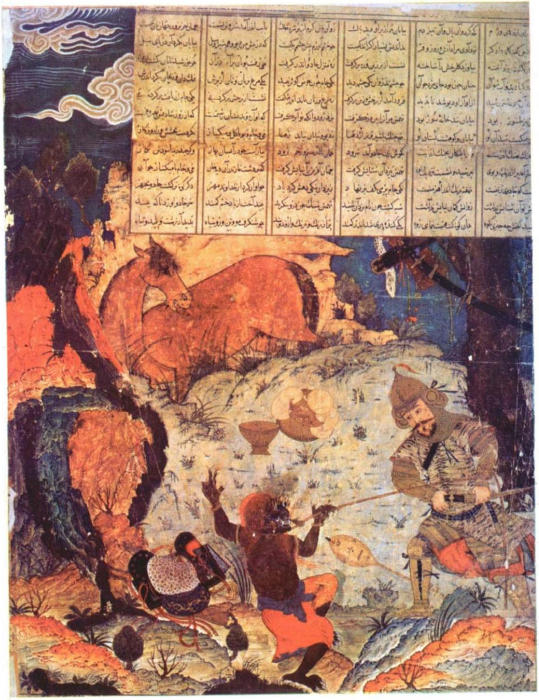Try Amazon Audible Premium Plus and Get Up to Two Free Audiobooks

Shop Amazon - Create an Amazon Baby Registry
Rustam Killing the Witch in Mazandaran
Illustration of Jalayrids from a late 14th Century Shahnama
The figures wear contemporary dress or dress of no latter than the date of the illustration.

A larger image of Rustam Killing the Witch in Mazandaran, Shahnama, Jalarid Tabriz, Iran
From the Sarai Albums, Tabriz, 1370AD. Hazine 2153, folio 103b Topkapi Sarai Museum.
Image source: Resim (Plate) 9, Topkapi Saray Muzesi Islam Minyaturleri
Rustam Killing the Witch (fig. 23).
Rustam sets out for Mazandaran, the land of giants and witches.
After a long journey he comes to a grove where, to his surprise, he finds food and drink by a fountain.
This was, in fact, the table of the witches who had run away when they heard him approaching.
Rustam sits down, helps himself to food and drink, and then starts playing a lute that he found there.
A witch, disguised as a young, pretty girl, comes to him.
Rustam is so pleased with the turn of events that he thanks God.
At the mention of God's name, the girl’s face turns black.
Only then does Rustam realize what is happening and, passing a noose around her neck, orders her to show her true self.
He then kills her with his dagger.
The painting portrays the moment when Rustam has passed the noose around the neck of the witch.
He has twisted the rope of the noose around his left arm and is preparing to draw his dagger.
He wears a gold coat under a tiger skin and a gold helmet.
The witch, colored very dark almost purplish-brown, has a terrible appearance with long pointed nails and teeth.
In the bottom left is the saddle which Rustarn removed from his horse, Rakhsh.
Above, in the background, is the horse itself looking up from where it is grazing.
Behind Rustam is the tree on which he has hung his weapons.
The ground is reddish beige, with some grass here and there.
In the middle we see the cup and the food.
Text Source: "Four Istanbul Albums and Some Fragments from Fourteenth-Century Shah-Namehs" by Nurhan Atasoy, pp. 19-48 in Ars orientalis; the arts of Islam and the East Vol. 8 (1970)
Referenced by figures 176 & 179 in: M. GORELIK, "Oriental Armour of the Near and Middle East from the Eighth to the Fifteenth Centuries as Shown in Works of Art", in: Islamic Arms and Armour, ed. ROBERT ELGOOD, London 1979
Back to Illustrations of Jalayrid Mongols


